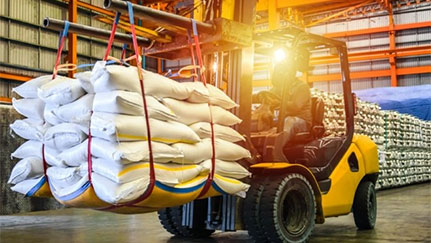5 tips for safer forklift operations

While a forklift is a quick and effective way to transport cargo, it’s also a vehicle for which safe operation is very important. This article provides tips for safer operation of forklifts and lift trucks.
Forklifts and similar powered industrial trucks (PITs) are a mainstay across all business sectors for the movement of materials. Their presence and operation often go without notice until an event with a serious injury, fatality or large loss potential occurs. Whenever lift truck or PIT use is a part of business operations, fundamental safety principles to prevent forklift-related accidents should be in place. Here are five tips to complement those basic principles and make for safer forklift operations.
1. Select the right equipment
When it comes to lift trucks, one size certainly does not fit all. Proper selection includes, among other factors, considering capacity, size, terrain, and environment. For example, a 900 lb. jib attachment could reduce the capacity on a lift truck from 6,000 lbs. to 1,500 lbs. if it moves the load center from 24 inches out to 60 inches. It is critical for safe operations that equipment selection includes not only the weight and size of expected loads, but also the impact of any attachments. By understanding how maximum capacity is negatively affected by larger load centers, higher lifting heights, and different attachments, the person responsible for equipment selection can ensure that operators have adequate capacity to work safely.
It is equally important to consider where the forklift will be operated, both the terrain and the working environment. Different terrains require selecting a model and wheel type that will ensure stability. Using a forklift meant for indoor use and a smooth floor in an outside, rough terrain environment can result in a load failure or an overturn event. Similarly, an environment with flammable or combustible atmospheres requires providing a lift truck rated for these atmospheres.
2. Provide adequate space
While the rear steer design of most lift trucks allows for some tight maneuvering, providing adequate space for safe operations is a design investment that will help avoid serious losses. Consider both the working space needed for the vehicle’s actions as well as the travel space required for other lift truck and pedestrian traffic. Remember, even at slow speeds the counterweight of a lift truck will produce enough force to result in serious property damage or personal injury, and a tight work area only increases this risk.
3. Improve visibility
Visibility applies both to the equipment and to the work environment. The more visible the lift truck is, the greater the opportunity for other drivers and pedestrians to safely interact and provide space. New technologies can equip trucks with leading and trailing safety lights that project an indicator line outward onto the floor surface to give other drivers and pedestrians a more effective advanced warning of the truck’s approach. Providing spot mirrors at turns and intersections allows for identifying oncoming traffic, while addressing potential lighting and glare issues in and between work areas ensures the driver can safely see what is in their travel path.
4. Protect against overturns and falls
Forklift overturns can occur while maneuvering on a smooth flat surface, rough terrain, inclines, or because the lift truck drives off an elevated surface. One of the greatest hazards in these situations is when the operator is not buckled in and gets caught beneath the equipment. Ensure that all powered industrial trucks are equipped with a seat belt that is clean and functional, and its use is mandatory. In forklift traffic areas, open loading docks should be protected by a physical barrier if the bay door is not closed, and any ramps with open sides should have curbing. Use safety yellow, high-visibility, and/or reflective materials to highlight hazards to the driver, but a physical control should also be in place. Safe practices related to securing dock plates, trailers, and rail cars should be established, meet or exceed applicable OSHA standards, and be strictly enforced.
5. Monitor operations
The only way to ensure proper equipment selection, operating design, engineering controls and foundational safety principles are working as intended is to take time to monitor operations. This supports the third essential function of the Plan, Do, Check, Act model for continuous improvement. Monitoring includes visual observations and collecting feedback from all the stakeholders involved in forklift operations – drivers, pedestrians/workers in the area, repair staff and possibly delivery drivers or the public. Visual observations can include both real-time events as well as residual indicators, such as damage to storage racks, skid marks on the floor from drivers doing “doughnuts” or missing/damaged safety equipment. The key is to validate if the planned controls are working effectively and, if not, determining the root cause(s) of why that is and making needed corrections.
For more information, consider the following resources:
